Cryonics for Pets
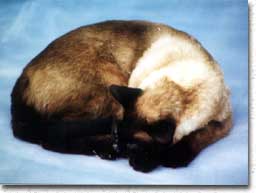
It's freezing cats and dogs!
Freeze drying
Plastination
 Apart from friends and family members, some people may also want to take their favorite pet(s) with them to the future. Technically and legally this isn't a problem; the standard cryonics protocol can be used on animals as well, and most bureaucratic barriers regarding euthanasia, transport & storage of remains etc. don't apply to pets so that, ironically, they can get a much better suspension than humans. The costs of a pet suspension, however, may be somewhat high for most people; $5,800 (Cryonics Institute) or $10,000 (Alcor), and this doesn't even include transportation costs to the cryonics facility. Taking into account that one probably has to use the services of a funeral director, these could be quite considerable, especially if you live outside the US (approx. EUR 7,000 - 10,000 (?) for humans, maybe it's a bit less for small animals, but that's by no means certain). Also, apparently this is a special service for Alcor/CI members only, not for the "general public", and only average-sized animals (cats or cat-sized dogs) are accepted at the above-mentioned prices; storage of larger animals could cost (almost) as much as human storage (i.e. $30,000 - 150,000!), assuming one can actually fit the animal into the cryostat/dewar. In other words, whole-body elephant suspensions are out of the question, though just about any animal's head or brain would presumably be ok, and its storage should even be available at the lower price since few pets' heads, and even fewer brains, will significantly exceed "cat size".
Apart from friends and family members, some people may also want to take their favorite pet(s) with them to the future. Technically and legally this isn't a problem; the standard cryonics protocol can be used on animals as well, and most bureaucratic barriers regarding euthanasia, transport & storage of remains etc. don't apply to pets so that, ironically, they can get a much better suspension than humans. The costs of a pet suspension, however, may be somewhat high for most people; $5,800 (Cryonics Institute) or $10,000 (Alcor), and this doesn't even include transportation costs to the cryonics facility. Taking into account that one probably has to use the services of a funeral director, these could be quite considerable, especially if you live outside the US (approx. EUR 7,000 - 10,000 (?) for humans, maybe it's a bit less for small animals, but that's by no means certain). Also, apparently this is a special service for Alcor/CI members only, not for the "general public", and only average-sized animals (cats or cat-sized dogs) are accepted at the above-mentioned prices; storage of larger animals could cost (almost) as much as human storage (i.e. $30,000 - 150,000!), assuming one can actually fit the animal into the cryostat/dewar. In other words, whole-body elephant suspensions are out of the question, though just about any animal's head or brain would presumably be ok, and its storage should even be available at the lower price since few pets' heads, and even fewer brains, will significantly exceed "cat size".
Perhaps there are cheaper ways to (privately) store pets privately; this is currently being investigated. Some -very crude and basic- suggestions have been listed below, ranked according to pricing and general feasibility, and more or less "reverse-ranked" by effectiveness (except for options #3 & #4). More details regarding these & other options, including detailed step-by-step protocols for DIY (pet) suspensions will be added as we go along.
General guidelines: when the animal dies and you're pretty sure you can have it either plastinated (option #2) or perfused and cryoprotected (by a cryonics organization) within a few days, it should be immediately cooled down to, and stored at, several degrees C above the freezing point (of water). For rapid cooldown, running ice-water is the method of choice. Click here for some practical tips. If you're going to try freeze drying (option #5) or cryogenic straight freezing (options #3 & 4), or simply aren't sure yet, you can put the animal in a regular freezer, highest setting. If you're going for alcohol storage (option #1), the animal should, after removal of the intestines (recommended for larger animals), be submersed in refrigerated alcohol a.s.a.p. If there's some kind of relatively short delay, the animal should be cooled but not frozen (yet).
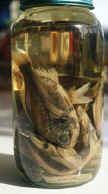
Fish in alcohol.
Option #1: Alcohol. An old and widely used preservation method. Put the animal's head, brain, or entire body (after removal of the intestines; this could be done by a vet or other "professional", if you can't do it yourself) in a glass, stainless steel, or plastic container (a drum; usually this is the best option) filled "to the rim" with alcohol (70-90% purity) or methylated spirit. According to Doug Skrecky, some sodium chloride (i.e. common salt) could be added to better preserve the DNA. Glycerine (5%) can also be added to the mixture; supposedly this helps to protect the specimen should the alcohol accidentally be allowed to dry up/escape -- something which, obviously, should be avoided at all times. The container should then be sealed and stored in a dark and cool place, ideally in a freezer (maximum setting, if applicable). Putting large dogs and large(r) animals in general -which require relatively large and heavy storage vessels- into a regular household freezer might be a bit problematic, though; even if the drum fits (and obviously it would have to be filled with alcohol after it has been placed into the box), the freezer's bottom might not be able to take the weight (long-term), and get damaged.
The container should be inspected from time to time for leaks etc., though these are unlikely. Also, make sure that no part of the animal is sticking out, the lid is closed properly, the container is placed in a stable position, and that whatever it is resting on can easily take the weight. Add supporting structure if deemed necessary. The primary container can be placed inside a slightly larger secondary container for additional safety.
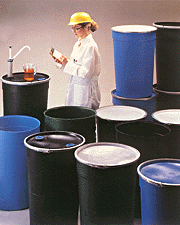 Alcor goes lo-tech...
Alcor goes lo-tech...
Tip: because body fluids will inevitably contaminate and dilute the alcohol during the first couple of weeks or months following immersion, it is recommended to fully refresh the vessel's contents at least once. This can be done after a few weeks, or as soon as the liquid starts looking cloudy or outright filthy. Ideally, the -pure- alcohol should be clear like Vodka. The glycerine, salt, and (possibly) other extras, which may or may not cloud the alcohol, should only be added after it has been refreshed.
Advantages: This is a very cheap, easy, and relatively low-maintenance method of preservation. Anyone can do it with off-the-shelf materials / gear, i.e. alcohol, a glass or plastic container, and a regular freezer (optional).
Disadvantages: Alcohol is a relatively poor preservative, at least from the cryonics perspective. Though biological specimens can be stored for many decades without any significant exterior degradation (Einstein's brain and the Tasmanian Tiger "clone pup" come to mind; the latter apparently "survived" 130 years or so of ethanol storage), it is said that under a microscope they look like "mush", even after just a few months [see for example this CryoNet message by Joseph J. Strout]. Unlike liquid nitrogen storage, alcohol or other chemical preservatives can only slow decay down somewhat, not stop it "entirely" (or rather slow it down to a pace where it becomes almost negligible). Refrigeration undoubtedly helps, but its effects are limited at normal freezer temperatures (approx. -20*C). Still, even poor preservation is better than the barbaric, willfully destructive alternatives, if only for moral reasons. Also, even what may today look like "mush" under a microscope could in fact contain a lot of useful information by future standards, maybe even enough for a near-perfect reconstruction -- certainly when combined with other data, such as video recordings, photos, writings, other people's (or animals') memories etc. It never hurts to try, in any case.
Another issue is the high flammability of "pure" alcohol. Handling will require due caution and common sense, i.e. keep the storage vessel well away from (potential) heat sources, make sure that it doesn't get damaged by sharp objects, regularly check for leaks, never handle it roughly etc. If you live in or near the Arctic region you might consider giving the container a permafrost burial.

Plastinated dog brains (Beagle), various angles.
Option #2: Plastination. Pet plastination is slightly easier than human plastination. There is at least one company that performs animal plastinations for private individuals: VisDocta Research in Italy. A dog brain costs approx. 1,100 EUR and a cat brain 800 EUR, "according to weight". The method used (and recommended) is whole-brain silicone impregnation, as opposed to slicing which is both more destructive and expensive. The pet's owner must present a "vet declaration" which states that the pet either died naturally or by means of euthanasia, and has no contagious disease. In most cases this will be just a formality; contact your local vet for more info. It is also recommended to contact VisDocta while your pet is still alive, to make sure that everything goes as smoothly as possible when the time comes.
Advantages: The procedure itself should be affordable to most (Western) pet owners. It's ultimately a matter of priorities; how much is the pet's (potential) survival / your own peace of mind worth to you? There should be relatively few legal restrictions regarding transportation & storage of plastinated animal specimens. Refrigeration (standard freezer) is recommended but not absolutely required, and in an emergency a plastinated brain would be very easy to evacuate; put it in some kind of box & off you go.
Disadvantages: Same technical uncertainties as with human plastination, but minus the added legal hassles. The further one lives from Italy, the more difficult (& expensive) it will be to get the pet's brain to the VisDocta facility (in time). Specimen retrieval / transportation can be taken care of by the company, but this will cost you approx. 1,000 EUR extra (could be more nowadays). However, even with these added costs this option is still much cheaper than having the pet shipped to the USA and frozen by either CI or Alcor (if you live in Europe, that is; for non-Europeans, VisDocta would be a fairly expensive option due to transportation costs).
Note: The idea behind brain-only plastination is of course identity preservation -- to "save" the true essence of the deceased animal (or person), so that its unique personality may be restored or recreated and inserted into a cloned or virtual body at some future date. From a purely practical perspective, the rest of the body doesn't need to be preserved, though it is highly recommended to have some cell samples stored with one of the cryonics organizations (see below) because plastination might damage the DNA. The latter is needed for cloning and additional identity reconstruction. Alternatively, you could use alcohol preservation (see above) to store the brainless remains, or simply make sure that at least some teeth and large bones -both traditionally used by researchers and forensic detectives to extract DNA long after the rest of the body has decomposed- remain cool and intact. Needless to say, burial is always preferable to cremation.
Whole-body plastination, though technically quite feasible and preferable from an aesthetic perspective, would probably be too expensive to fall in the "low budget" category. Still, people who would like to preserve their entire pet and don't mind paying somewhere between 5-15 thousand (?) EUR for it should definitely contact VisDocta. Again, separate cell sample storage would be highly recommended.
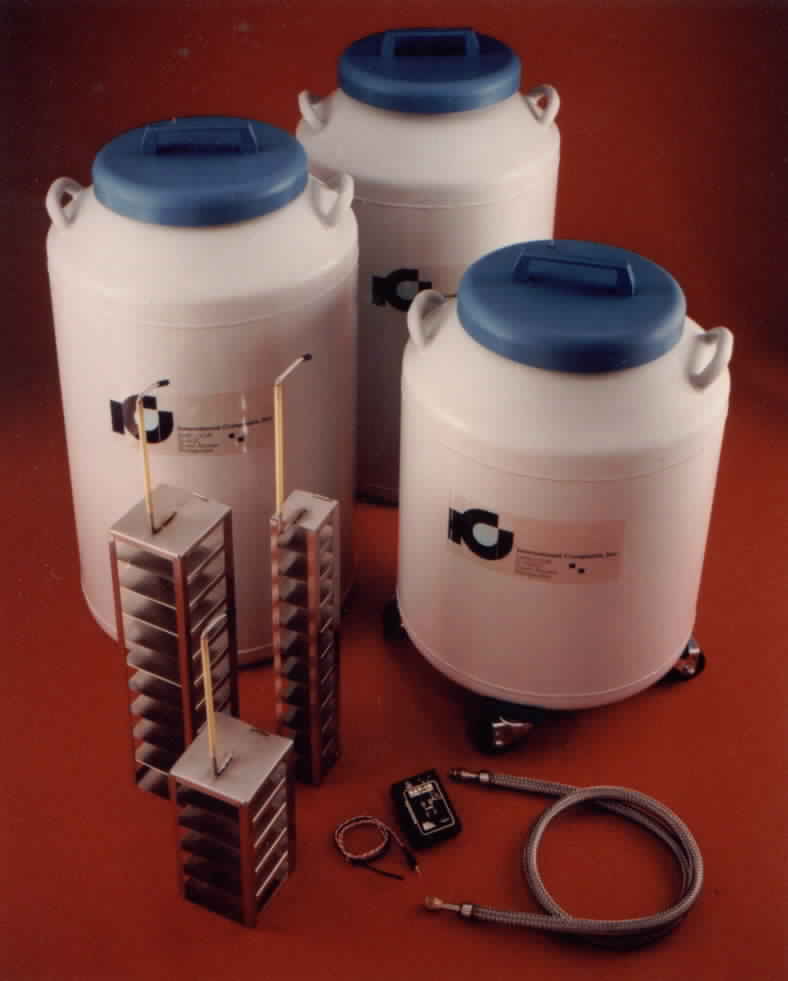
Wessington Cryogenic's Director series mini dewars.
Option #3: Buy or hire a small liquid nitrogen container, the kind that's normally used for the storage of small biological specimens in labs etc. Click here for some examples -- especially the D-4000 model at the bottom of the page looks quite promising.
Advantages: "Mini dewars" can have very favorable boiloff (LN2 evaporation) rates due to their advanced insulation and small necktube diameter, and only need to be refilled a couple of times a year according to the manufacturer(s). This, combined with their relatively mild pricing (D-4000: 1,745 UK Pounds, D-2000C: 1,525 UK pounds, see picture above), light weight, and compact size could make them a fair alternative for DIY pet preservations (or even human neurosuspensions, if you're willing & able to defy/outsmart the deathist bureaucracy). LN2 storage is probably the best means of identity preservation there currently is, even if you do a straight freeze without cryoprotectants (note: alternatives to straight freezing will probably be added at some point. In the meantime, see for example the article "Freeze and dry later" by Douglas Skrecky in Longevity Report 48). At -196*C decay is negligible, and though severe by current standards, it's not unreasonable to assume that future scientists and/or AIs will use their undoubtedly far superior knowledge regarding ice crystal formation and its effects on tissue to extrapolate the original, "functional" state from the damaged state, certainly if additional, external data (as mentioned earlier) is available.
Disadvantages:
The containers' relatively small size and neck diameter are both their strong & weak points. While helping to keep things affordable and manageable, they also make it impossible to store a (larger animal's) whole body, or even a large head -- the largest neck diameter is typically 21,6 centimeters. Most pet brains should fit, though, and if necessary they could even be cut up into two or more pieces (this kind of damage is relatively trivial compared to that caused by ice crystals, and should be relatively easy to repair with nanotech etc.). A bigger issue is the fact that LN2 containers need to be refilled at least several times a year, and the LN2 pricing per liter tends to be pretty steep when such small quantities are involved. On the other hand, it won't be more than, say, 500 - 1,000 EUR a year, which should be affordable to most persons, especially if you share the container with some other enlightened pet owners (and placing the container(s) in an insulated, for example wood & styrofoam box could help to further reduce LN2 boiloff, and thus the annual maintenance costs) . Even a relatively small vessel should be able to accommodate several heads or brains.
Also, liquid nitrogen is dangerous stuff! In order to prevent hardcore freezer burn, asphyxiation, and damage to the unit (which, in extreme cases, might even cause explosions) one has to observe some basic safety precautions. Your dewar / LN2 supplier will (should!) provide you with the necessary info.
Another important point to consider is that it may be illegal in some (many?) areas to deliver LN2 and other sealed gases to private homes. Apparently, this is the case in California.
Tip: In some cases you can get both dewar and LN2 from the same supplier (for example HoekLoos in the Netherlands). Check out the dmoz.org cryotechnology directory for an international list of suppliers, or do a "local" search on Google.
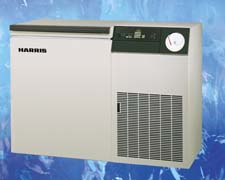
Harris Cryostar cryogenic freezers.
Option #4: Buy or hire a cryogenic freezer, such as the Harris Cryostar. Some of these can cool down to -150*C. (note: alternatives to straight freezing, which is the current DIY standard, will probably be added at some point. In the meantime, see for example the article "Freeze and dry later" by Douglas Skrecky in Longevity Report 48).
Advantages: Cryogenic freezers are high-tech, usually high-quality machines with many user-friendly features. They use electricity instead of liquid nitrogen which eliminates all kinds of (potential) handling & supply problems. They're very "discreet"-looking (i.e. they look pretty much like a regular freezer) as well, and the units are both larger and better accessible than the above-mentioned mini dewars.
Disadvantages: These things don't come cheap; a Cryostar will set you back approx. $16,000 + shipping. Similar pricing can be expected for other brands, give or take a couple of thousand $$/EUR. Because this option is in fact more expensive than having the pet shipped to the USA and stored "professionally" by CI or Alcor, it is only interesting if you plan to purchase a unit with a group of people. Let's say one could, if necessary, fit some 20 - 30 animal (or human!) brains or heads into the freezer (or whole bodies if the animals are small enough), and the total set-up costs are approx. $18,000. If purchased collectively, the costs per person would be $600 - $900 p.p., assuming a group of no less than 20, and no more than 30 people. Annual electricity costs, probably somewhere between $1,000 and $2,000, could be split on a similar basis, making them relatively trivial (somewhere between $30 and $100 p.p.). Even if more than half of the original participants would eventually lose interest and stop paying (payments should ideally be automated and semi-annual or quarterly), the operating costs would remain fairly manageable. Of course, one could also request larger, one-time up front payments, and put (most of) the money in an investment fund like the cryonics organizations do. This approach has its own risks, drawbacks, and advantages, but it's definitely an option. The freezer could be stored at a member's residence, thus eliminating the need to rent space (not that the costs of renting a couple of square meters in some business park would be a huge obstacle in the first place, but it might be safer to store the freezer in someone's home).
Secondary concerns are power & mechanical failures. Packing the specimens in dry ice should add a fairly decent extra safety margin, but moving them to another location in an emergency might be a bit tricky (unless, of course, they've been plastinated or freeze dried). Finally, -150*C will inevitably be less effective against biological decay than -196*C (LN2). For relatively short-term storage (a couple of decades at most -- we're definitely not talking centuries here. Click here to find out why) this may hardly matter, though.
Note: needless to say, cryogenic freezers and mini dewars could also be used for human preservation. Most of the above pros & cons would still apply, with two notable exceptions. First the bad news: the "private", non-medical / scientific storage of human remains is at best a grey area in most countries' legal frameworks, at worst outright forbidden. It might be possible to find some legal loopholes, or even have the laws changed, but this could very well be a slow and frustrating process. It might be necessary to store the freezer / dewar in an American cryonics facility until a solution has been found in Europe. This would obviously add all sorts of extra costs and other hassles, which would effectively wipe out most of the advantages of the collective freezer option. Now for the good news: due to the longer average life span of humans, one might use a simple but effective trick to significantly reduce the costs per person: make the collective larger than the freezer's / dewar's capacity! If the latter is, say, 20 brains (freezer), then one could form a group of up to 100 or so people. Should the first freezer / dewar fill up to capacity, which isn't likely to happen anytime soon judging from cryonics organizations' statistics, the group could simply attract a few more members and buy a second freezer / dewar. "Huge" sums are reduced to relatively manageable amounts if you join forces and harness the power of economies of scale. United we freeze, divided we rot! If a location in Europe can be found where frozen human remains can be stored legally, or if interested parties are willing to make this a "clandestine" operation, it might be worth considering.
Option #5: Have the pet freeze dried. [Under construction. In the meantime, check out the freeze drying section --and specifically its commercial pet preservation links-- above if you haven't already. If you live in North America, this might in fact be the best low(er) budget pet preservation solution. Incidentally, the cat and dog pictured at the top of the pet section aren't asleep or freshly deceased -- they're freeze dried. Looks pretty good, huh? From an aesthetic / emotional perspective at least, this seems to be the #1 choice. Once the pet has been freeze dried it should preferably be stored in an oxygen and water proof (plastic, stainless steel, or glass if the pet is small) container which is packed with ample quantities of a desiccant such as calcium oxide. The container should then be put in a (regular) freezer. Though the freeze drying companies claim that the animal can be displayed unprotected at room temperature, protected and refrigerated storage is highly recommended if you're serious about long-term preservation.]
Save Your Pets -- They May Save You
The information used to reconstruct you from cryonic suspension may not
necessarily all come from your brain. For example, some memories may be
"weak" upon reanimation and may need some extra assistance, such as a
videotape of you or some personal notes that you had written, to put them
firmly back into place. Also, everyone who knows you has a great deal of
information about you, much of it unconscious. Thus, having your friends
and family cryonically suspended may also improve the quality of your
reanimation, because extracting their information about you may provide
clues to help improve the fidelity of your reconstruction. And if the
information about you embodied in your friends and family can help, then
why not your pets, too?
-- Kevin Q. Brown, CryoNet archives. The original message can be found here.
For those who see cloning as an acceptable alternative to body / brain suspension: CI also offers pet (and human!) cell preservation services, for members, at no maintenance cost whatever, for only a $49 sampling kit and $49 shipping and cryopreservation fee (total costs: $98). ACS offers a comparable service: preservation of a DNA sample through an arrangement with Third Millennium Research, Inc. of Seattle, Washington. Pricing: $49.50/$50.00 for full members. This preservation is at room temperature in a glass vial. Custody of the vial may be undertaken either by ACS or by the member. Also available for $150.00 is the indefinite cryogenic storage of a biological tissue sample. This does not include the costs of taking the sample, shipping costs, etc. It is not quite clear, however, whether either of these (ACS's) options is available to non-members as well, or indeed available at all (contact them for more info). Alcor was setting up a separate, for-profit company called Cells4Life, Inc., that would specialize in tissue sample storage (for the general public as well as Alcor members), but the initiative has apparently been cancelled / postponed indefinitely. There are several other companies that offer cell storage services, but these tend to be considerably more expensive than CI & ACS'. See the list below for some (old, so pricing & other details may have changed) examples.
- Canine Cryobank Has a new, easy sampling protocol that only requires a blood sample. Kits are $150.00 each to a pet owner, costs for the cell cultures are US$365.00, and storage is $75.00 per year (there might also be a separate "processing fee" of $215.00 -- this is not entirely clear). Contrary to what the name suggests, the do accept other mammals (and their semen, by the way), not just dogs. Worldwide service. Claim to have been around, as sperm freezers, for at least 17 years, which is a great plus (but again, by no means a guarantee for anything).
- Genetic Savings & Clone (GSC) Brought to you by the people behind the world-famous Missyplicity dog-cloning project. The price for "standard" service orders is $895 each, plus shipping. There's also an emergency service for terminal or recently deceased animals (up to one week post-mortem depending on storage conditions), which costs $1395, plus shipping. The annual maintenance fee for Standard jobs is $100.00 per year, versus $150.00 for Emergency jobs (which involve twice as much tissue). The first year's maintenance is included in the initial service fee for both grades. Skin samples (biopsy) required. All in all this looks like a very professional, albeit somewhat expensive, service.

The Human Cloning Foundation has the largest, busiest, most interactive pro-cloning site on the internet. Here you can join their fight against popular & bureaucratic ignorance, hysteria and prejudice!
Cryogenic tissue storage could be used in combination with plastination or some other relatively cheap & convenient form of chemical preservation, for example, to preserve as much structure and genetic information as possible. We'll stay on the lookout for other (possibly better) alternatives, though. Join the mailing list if you want to be kept up to date regarding these and other developments.
